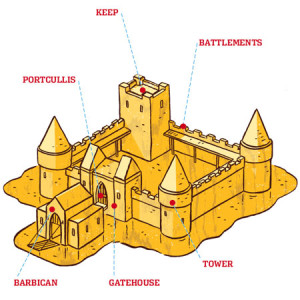[A short digression on my preference for custom sandbox settings suggested by the previous post on the Curabel campaign design. My apologies on the lack of updates since the initial flurry of posts. My hope is to get back on at least a weekly posting schedule starting with the next installment of my campaign design series this weekend.]
I’ve always run sandbox campaigns, even back in the 80’s in school when I wouldn’t have known what that meant. This wasn’t a conscious choice, though, just an accident dependent on my interests and limitations as a DM:
1. I have never been able to run someone else’s campaign or module — they’re the projections of someone else’s imagination and always feel foreign to me. I can borrow a general theme, minor detail, or random table and rework it so that it becomes mine, but that’s about it. For instance, I’ve thoroughly enjoyed reading through Zak S.’s Red & Pleasant Land and David McGrogan’s Yoon-Suin settings recently and could see myself playing in them or even stealing individual ideas for my own use, but those are not my worlds and I don’t have that gut feeling for their ‘reality’ that I get with my own creations.
2. I have always loved creating campaign milieus and explaining how everything got the way it is before the players start breaking/interacting with it. I do this for myself, though, so never feel compelled to ram it down the players’ throats — it’s a largely invisible (from the players’ perspective) web of causes and effects.
3. Determining the why and wherefores of a campaign world has always highlighted for me the underlying concepts that are firing my imagination. Knowing that makes riffing on player choices off-the-cuff much easier. They can yank on any adventure string they want, but I know the thematic ball of yarn to which they ultimately connect.
So, to run through the process backwards: I’ve always had a knack for improvisation based on player choice (the bedrock of sandbox play) because I have a good sense of my campaign worlds’ themes and history. I have a good sense of those themes and history because I only use my own material and spend a good bit of time rationalizing the components of that material. I only use my own material because I delight in creating it for its own sake and suck at empathizing with or ingesting the finished ideas of others.


I am much the same way. I can run modules and so forth, but I have to put so much time into getting the feel for them, that it is easier to use ideas and incorporate into my own setting.
To be honest, I’ve never run a module even though I buy them from time to time just to see what’s happening in the wider RPG world and what can be appropriated for my own material. Leaving aside modules, the only time I attempted to run a predefined campaign setting was right after Forgotten Realms was first published. I ended up keeping the map and ignoring just about everything in the setting books. For a while after that I would check in on the “official” FR material that overlapped the areas I used (Cormyr and the Inner Sea region, I think) just to see how far my creation was from the canonical version.
Back to the original point, though, using someone else’s setting feels like writing fan-fiction — so much energy is expended on emulating the imagination of the original creator that everything else suffers. I imagine that this is a personal failing, though, and that others are perfectly capable of using these materials successfully.
So what was the first one you did?
I’m not sure what you mean — like I mentioned in my reply to Larry, the only published setting I’ve used was Forgotten Realms when it was new (although I completely ignored the official lore and only kept the maps). The first module I bought was Sinister Secret of Salt Marsh, but I’ve never run it or made use of its material.
If you’re asking what the first campaign setting I created was, I have only a spotty memory of it — it was a huge world with a cursed desert kingdom that the party ended up freeing by leading an army of dwarves under the mountains to surprise their enemy. The desert kingdom and its transformed heir (snake-headed with a articulated and piston-powered iron jaw) I remember as being a completely random and spur-of-the-moment invention who attacked and stole some minor treasure from the group that turned out (to my surprise) to be some key artifact for his people — the group was convinced that their epic quest to free that kingdom initiated by that event was some detailed plot created ahead of time but really it was me just riffing on their choices and fleshing out the setting’s history week-to-week with the occasional random determination as they moved across the map.